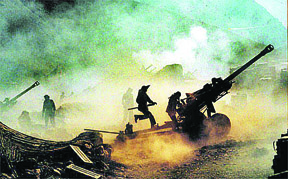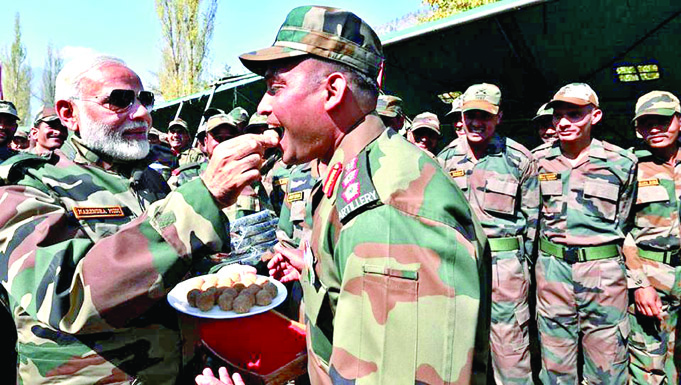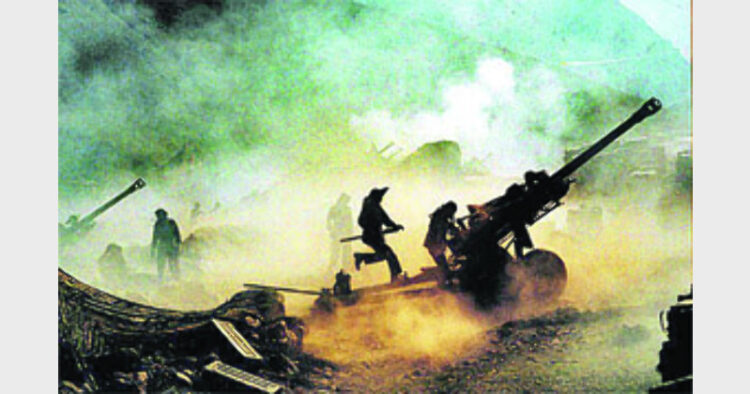A review of the progress made in India’s security calculus, subsequent to the recommendations of the group of Ministers post-Kargil Conflict

A file Photo of Indian Army during Kargil War
•As of date, nearly two decades after the submission of the report, a large number of recommendations have been implemented, but certain key issues still remain to be addressed
•There is perhaps the need to have a National Information Advisor (NIA) on the lines of the NSA as shaping the information environment is a huge task that requires tremendous resource
I n late January/early February 1999, the Pakistan military launched “Operation Badr,” with a view to dominate the Kargil heights. The plan was to initially avoid confronting the Indian forces by moving stealthily along the gaps not held by the Indian Army. Thereafter, after consolidating their positions by the latter half of May, they were to disclose themselves and demonstrate that they were in control of the heights along a ‘new LOC,’ before the opening of the Zojila Pass. As per the Pakistan military assessment, Indian forces would need time to assemble their forces, acclimatise their troops and build up their logistics which would be difficult before Zojila opened. They would also have to suffer unacceptable casualties in attacking the heights. This would ensure time enough for an internationally arranged ceasefire, leaving Pakistan in control of the heights.
As a tactical plan, it was brilliantly conceived and executed. The strategic premise on which Pakistan based its plan was however flawed on two counts. First, it underestimated the Indian will to fight and recover the territories taken by the infiltrating force. Second, it was premised on the hope that the major powers would force an early ceasefire to prevent the conflict from degenerating into a nuclear exchange, leaving Pakistan in control of the heights. That strategic miscalculation was to be the undoing of Pakistan. By July the infiltrators were driven back from most of the localities they held and India only agreed to a ceasefire on the condition that Pakistan withdraws its forces behind the LOC, effectively restoring the status quo ante.
The armed intrusion by Pakistan in the Kargil sector had however come as a complete and total surprise to the Indian Government, the Army, the intelligence agencies as well as to the Government of J&K and its agencies. This was a lacuna in the Indian defence apparatus and post the Kargil War, the government set up a four member Review Committee called the Kargil Review Committee (KRC) under the chairmanship of K. Subrahmanyam, to look into the causative factors and give a report on the deficiencies in India’s security management system.

Prime Minister Narendra Modi offers sweets to a jawan on the occasion of Diwali in Gurez
The KRC was given access to all classified documents and it brought to light numerous deficiencies, especially in the field of Intelligence, Border Management, and Defence Management. Subsequent to the Committee submitting its recommendations, the Prime Minister, Shri Atal Behari Vajpayee, set up a GOM (Group of Ministers), to consider the recommendations of the KRC and formulate specific proposals for implementation. The GOM consisted of the Ministers of Home Affairs, Defence, External Affairs and Finance. This was the first time in the history of Independent India that a review of the nation’s national security structures was carried out in their entirety. Besides the four ministers mentioned above, the National Security Advisor (NSA) was also co-opted as the special invitee.
The GOM appointed four task forces to look into the Intelligence Apparatus, Internal Security, Border Management and Management of Defence. After its deliberations, the GOM submitted its voluminous 137-page report, containing a large number of recommendations to enhance efficacy in each of the four issues enumerated above. As of date, nearly two decades after the submission of the report, a large number of recommendations have been implemented, but certain key issues still remain to be addressed. These are discussed in succeeding paragraphs:
Intelligence
One of the recommendations was the need to create a Defence Intelligence Agency (DIA). While the organisation has been created, its functioning, in terms of resource availability and tasking leaves much to be desired. There is a need for greater appreciation of the role of intelligence and who needs it most and also more understanding with regard to who must pursue any given lead. The Research and Analysis Wing (R&AW) still has a monopoly on external intelligence, and there is no redundancy in the system. It is neither healthy nor prudent to endow a single agency with multifarious capabilities for human, communication, imagery and electronic intelligence, that is why the DIA must be further empowered to gain battlefield intelligence. As of now, the DIA has limited capability. Intelligence is only available by way of Satellite Imagery, Signal intelligence through monitoring of enemy”s transmissions and inputs which are provided by the Defence Attaches. There is no capability or funding to obtain intelligence for commitments at the Operational level or at the Strategic level. The need for empowering the DIA with funds to develop sources and obtain Hard Intelligence is essential and needs to be done. There also needs to be institutionalised sharing of intelligence by the intelligence branch of the three Services with the DIA.
Internal Security
The GoM recommended that the National Security Council (NSC)/Cabinet Committee on Security (CCS) should evolve an effective counter-strategy against the threats posed by the Pakistan ISI, which should be proactive rather reactive. No information on this is available, as the subject matter is rightly classified. However, if anything in this regard has been done, it certainly has not achieved the desired results on the ground, where, to all intents and purposes, it appears that our policy is still reactive.
A major recommendation was the need to modernise the police forces. This is still a work in progress, though some improvements are visible in those states that are impacted by Left Wing Extremism.
With respect to counter-insurgency (CI) operations, the GOM recommended that the CI role should be progressively taken over by the CRPF. To this end, a large number of CRPF battalions have been raised and today, the CRPF has over 3,00,000 personnel on its rolls. But it still lacks the capability to independently address IS challenges. The Force remains poorly trained and suffers from weak leadership and while it is effective in static roles, its performance in mobile operations remains suspect.
Border Management
Most recommendations with respect to effective border management have been implemented or are in the process of being implemented. Border Area Development Programme (BADP) is a continuous programme which is being implemented. The land boundary with Bangladesh has been demarcated and the vexed issue of enclaves have finally been settled. The maritime boundary with Bangladesh has also been settled. Fencing has been constructed all along the Indo-Pak border and most areas of the India-Bangladesh border.
The ITBP is deployed along the Indo-China border, but it operates under the MHA. Considering the fact that the border is disputed, it would be better if the Force is placed under the operational control of the Army.
The India Myanmar border is guarded by the Assam Rifles. This is an appropriate arrangement as the Assam Rifles, being a paramilitary force, works in close liaison with the Indian Army, which is engaged in CI operations in the Northeast. There appears to be a proposal to hand over this border to the BSF, which is a Central Armed Police Force (CAPF), but such an arrangement will have negative consequences on the CI grid established in the Northeast and will also entail huge expenditure in terms of the additional raising of BSF battalions. The status quo in respect of the Indo-Myanmar border is thus recommended to be maintained.
With respect to the India Myanmar border, the issue of fencing the border as was done in case of India’s border with Pakistan continuously crops up. This is, however, a retrograde step as the challenges in border management on the Myanmar border are totally different from those obtaining on India’s border with Pakistan.
The GOM recommended the setting up of a Marine Police Force in all coastal states and island territories, as has been done in the Andaman and Nicobar Islands. This is still a work in progress.
Information Management
This is an area where a great deal of work still needs to be done. The national electronic media still does not reach most of the border areas, while such areas are covered by Chinese and Pakistani radio and television channels. India’s efforts at shaping the information environment in conflict zones of J&K, Northeast India and areas impacted by Left Wing Extremism remain weak. This is a serious lacuna and calls for a more active media policy. There is perhaps the need to have a National Information Advisor (NIA) on the lines of the NSA as shaping the information environment is a huge task that requires tremendous resources. It is also vital that AIR and Doordarshan penetrate to the remotest corners of the country.
Management of Defence
As per the recommendations of the GOM, a Strategic Forces Command (SFC) has been established which is functional as of date. This has enhanced India’s strategic response options. Another recommendation, however, pertaining to the appointment of a Chief of Defence Staff (CDS), to render single point advice to the Defence Minister has yet to see the light of day. Towards this end, Headquarter Integrated Defence Staff (IDS) has been established, headed as of now by the Chief of Integrated Staff Committee (CISC), but a CDS still remains to be appointed. In the absence of a CDS, the functions are carried out by the Chief of Staff Committee (COSC), but in its functioning, this arrangement continues to have serious weaknesses in its ability to provide single point advice to government and resolve substantive inter-service doctrinal, planning, policy and operational issues.
The GOM also recommended revamping of the defence acquisition procedures. A lot of work has been done on this score in the last four years, and a new defence acquisition policy has been issued. The recommendation pertaining to synergising the Ordnance Factories Board, the Defence Public Sector Undertakings (DPSU) and the Defence Research and Development Organisation (DRDO) received little attention from 2004 to 2014. The NDA Government thereafter has attempted to revitalise these institutions, but this too remains a work in being. A large number of ordnance factories need to be closed down, some need to be privatised and the rest modernised. The same goes for the DPSUs, whose performance in comparison with the private sector remains poor. The procedures, systems and methods to manage these institutions require substantive re-examination.
The GOM recommended integration of the Service Headquarters with the Ministry of Defence (MOD). Besides a change of name, no integration has been carried out and the Indian MOD perhaps is the only such ministry in the world which has no military officers. A complete overhaul and restructuring of the MOD are required so that at least fifty percent of the staffing is from the military. At some future point, the Defence Secretary should also be an officer from the Armed Forces and not from the Civil Services.
In conclusion, many recommendations of the GOM have been implemented, but certain major reforms are still to take place. It is unfortunate that the previous UPA Government did little to implement the recommendations in its ten-year tenure from 2004-2014. The last four years have seen some forward movement but matters pertaining to defence and national security are long-term issues and cannot be compressed in time. It is hoped however that the process is continued with vigour, to enhance the nation’s security.
(The writer is a former Director at CLAWS)













Comments